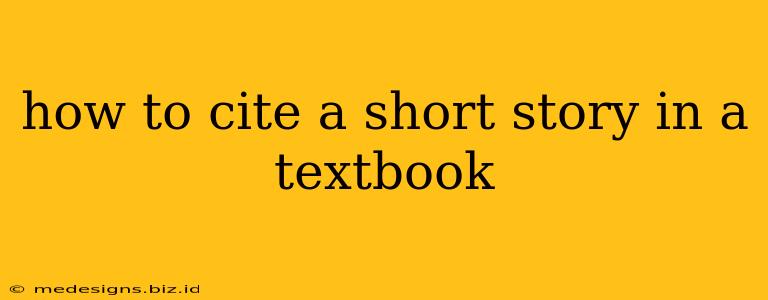How to Cite a Short Story in a Textbook: A Comprehensive Guide
Citing sources correctly is crucial for academic integrity. When you're using a short story found within a textbook for a research paper or essay, the citation style you use will depend on the required format (MLA, APA, Chicago, etc.). This guide will walk you through the process for the most common styles. Understanding the nuances of each style is key to avoiding plagiarism and showcasing your research effectively.
Understanding the Components of a Textbook Short Story Citation
Before diving into specific style guides, it's essential to identify the key pieces of information you'll need to include in your citation:
- Author of the Short Story: The person who wrote the story.
- Title of the Short Story: The name of the short story, enclosed in quotation marks.
- Editor(s) of the Textbook: The person or people who compiled the textbook.
- Title of the Textbook: The name of the textbook, italicized.
- Publisher: The company that published the textbook.
- Publication Year: The year the textbook was published.
- Page Numbers: The page range where the short story appears in the textbook.
Citation Styles: A Detailed Breakdown
Here's how to cite a short story in a textbook using the most popular citation styles:
MLA (Modern Language Association)
The MLA style emphasizes brevity and focuses on the author and work. For a short story in a textbook, the citation looks like this:
Example:
Chopin, Kate. “The Story of an Hour.” The Norton Anthology of American Literature, edited by Robert S. Levine et al., 9th ed., W. W. Norton & Company, 2018, pp. 1234-1245.
Key Points:
- The author's last name and the short story title are given first.
- The title of the anthology is italicized.
- "Edited by" is included if applicable.
- Page numbers are crucial.
APA (American Psychological Association)
APA style prioritizes clear and concise information, often used in social sciences and psychology. The citation format for a short story in a textbook is:
Example:
Chopin, K. (2018). The Story of an Hour. In R. S. Levine et al. (Eds.), The Norton Anthology of American Literature (9th ed., pp. 1234-1245). W. W. Norton & Company.
Key Points:
- Author's last name and initials are used.
- Year of publication is placed in parentheses.
- The editor's names follow "In" and are formatted as (Eds.).
- Page numbers are included in parentheses.
Chicago Style (Notes and Bibliography)
Chicago style offers two main systems: notes and bibliography. The bibliography entry for a short story in a textbook is:
Example:
Kate Chopin, “The Story of an Hour,” in The Norton Anthology of American Literature, 9th ed., ed. Robert S. Levine et al. (New York: W. W. Norton & Company, 2018), 1234-45.
Key Points:
- Similar to MLA, but the publication information is included in the bibliographic entry.
Tips for Accurate Citation
- Double-check the details: Always verify the author's name, title, publication details, and page numbers for accuracy.
- Consult your style guide: Refer to the most up-to-date edition of your chosen style guide for any specific rules or updates.
- Use a citation management tool: Tools like Zotero or Mendeley can significantly simplify the citation process and help ensure consistency.
- Seek help if needed: If you're unsure about any aspect of citation, consult your instructor or a librarian.
By following these guidelines and paying close attention to detail, you can confidently and accurately cite short stories from textbooks in your academic work. Remember, proper citation is essential for avoiding plagiarism and demonstrating your scholarly rigor.
